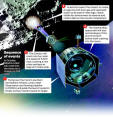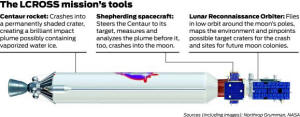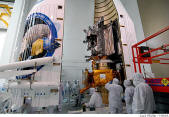|

by
David Perlman
Chronicle Science Editor
Thursday, June 18, 2009
This article appeared on page A - 1
of the San Francisco Chronicle
from
SFGate Website
A California spacecraft, bound for deliberate doom inside a crater
on the moon, is scheduled to soar into space today, along with a
lunar orbiter searching for safe landing sites where humans
might one day establish Earth's first colony.
   
In early October, the spacecraft will
send a heavy rocket crashing into the moon's south polar region on a
mission to find water that could support future crews bound for
Mars. With its mission finished, the spacecraft itself then will die
in its own final crash into the lunar surface.
The water-seeking mission was conceived, developed and now is
controlled by space scientists and engineers at NASA's Ames
Research Center in Mountain View.
Their spacecraft bears the unwieldy name of
LCROSS
- the Lunar Crater Observation and Sensing Satellite - and in
a sense is merely hitching a ride on an Atlas rocket whose main job
is to launch NASA's new
Lunar Reconnaissance Orbiter. That spacecraft will
spend at least a year creating the most minutely detailed map of the
moon's surface ever seen.
Flying over the moon's southern hemisphere, LCROSS will use its
high-precision instruments, as well as close-up images of the
terrain gathered by the lunar orbiter, to seek out a crater just
shallow enough and dark enough to be a prime bombing target.
There, acting as what the Ames team calls its "shepherding
spacecraft," LCROSS will guide an empty Centaur rocket weighing two
tons toward its target. The rocket will crash into the crater at
5,600 mph, creating a new crater - perhaps as large as 5 miles
wide.
The crash is scheduled to occur
October 9, 2009.
Scientists on Earth expect the impact to blast out a huge cloud
of dust, gas and vaporized water ice at least 6 miles high. The
cloud will be clearly visible to astronomers at Earth-bound
observatories and the Hubble Space Telescope's new planetary camera,
allowing each to observe and collect data on its composition.
Astronomers have long thought that a rain of comets brought water to
the arid, lifeless moon over billions of years. In the past few
years, at least two American spacecraft reported the presence of
water by detecting hints of hydrogen and oxygen - the constituents
of water - frozen deep in the darkest recesses of craters around
both the north and south lunar poles.
Because an ample supply of water could help provide unlimited fuel
for any future moon base, seeking it out has been a high-priority
mission for NASA leaders still bent on implementing former President
George W. Bush's "vision for
space exploration" that Bush said would start with "a foothold
on the moon."
Whether the
Obama administration pursues that
goal with as high a priority remains an open political question.
But to Anthony Colaprete, a planetary physicist and chief
scientist for the LCROSS mission, the brilliant burst of matter his
crashing Centaur will eject is the ultimate goal of the current
mission.
"In only a few seconds, we'll see
the brilliant flash from the crash," he said Wednesday from Cape
Canaveral.
"The ejecta should show first as a
single bright, shimmering star; we're calling it sunrise.
Seconds later, even modest telescopes on Earth should see two
blurry stars as the ejecta spreads wider and higher."
Those blurry lights would show as stars
of the fourth or fifth magnitude, Colaprete said - possibly as
bright as the Andromeda nebula.
That spectacle may last only 60 seconds
or so, Colaprete said, but it will signal that the Centaur's
crash has created a fresh crater up to 5 miles wide at a
carefully selected spot inside the larger target crater.
Within 10 minutes, dense material ejected from that crater should
rise some 6 miles high, with the water ice - perhaps billions of
years old, if it exists at all - turning instantly to vapor. And
within an hour, detectable hydrogen and oxygen should rise as high
as 60 miles, according to calculations by Colaprete's team at Ames.
After the Centaur rocket crash, LCROSS, its fuel spent, will slam
into the lunar surface as well, its job done.
The lunar orbiter, meanwhile, will continue its looping flights
around the moon from pole to pole, and as the moon rotates beneath
it, the orbiter will eventually have mapped the entire surface. On
the way, it will send back images of flat regions inside or beyond
the craters - the flat areas to be listed as potential sites for
future lunar bases, if and when those bases are to be built.
The launch from Cape Canaveral is scheduled for 2:12 p.m. PDT today
(below video.)
LAUNCH LRO LCROSS SPACECRAFT ATLAS V
18 JUNE 2009
|





